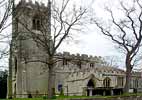 Misson Misson
St John the Baptist
Archaeology
The church consists of nave, north and south aisles, south porch, chancel and west tower.
The church was restored in 1882, 1886 and by Charles Hodgson Fowler in 1894.
Exterior features
  The west tower was originally built in the 14th century and after severe damage from a lightning strike was restored in 1894. It is of two stages with angle buttresses and has a crenellated parapet with four crocketed pinnacles. The west tower was originally built in the 14th century and after severe damage from a lightning strike was restored in 1894. It is of two stages with angle buttresses and has a crenellated parapet with four crocketed pinnacles.
 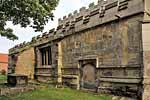 The four-bay north aisle dates from the 15th-16th centuries and has a large 19th century rubble buttress. The four-bay north aisle dates from the 15th-16th centuries and has a large 19th century rubble buttress.
 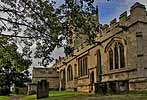 The five-bay south aisle dates from the 14th, 15th and 16th centuries (the three bays to the west are the earliest) The five-bay south aisle dates from the 14th, 15th and 16th centuries (the three bays to the west are the earliest)
 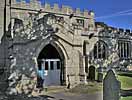 The 14th century south porch has a four-bay stone vaulted roof The 14th century south porch has a four-bay stone vaulted roof
Interior features

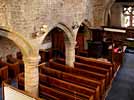 North arcade North arcade |
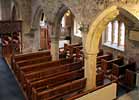 South arcade South arcade |
The north nave arcade appears to date from the late 13th - early 14th century, and the south arcade from the 14th century; both are of three bays.
The north arcade has two circular piers with canted square octagonal bases and moulded octagonal capitals.
The south arcade has two octagonal piers with canted square bases, moulded octagonal capitals and moulded octagonal responds.
The arches of the north arcade are less pointed than those of the south.

 Chancel south arcade Chancel south arcade |
The chancel north arcade consists of a western 13th century bay and has half round imposts with moulded circular caps; the 14th century eastern arch is double chamfered and rebated with moulded octagonal imposts.
The 14th century chancel south arcade is of two bays and has central octagonal pier with canted octagonal base and moulded octagonal cap, and moulded octagonal imposts. The arcade contains a 12-bay 19th century timber screen, Decorated in style.
 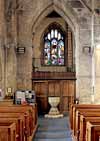 The 14th century double chamfered and rebated tower arch was opened out 1886 and is flanked by substantial tower buttresses. The 14th century double chamfered and rebated tower arch was opened out 1886 and is flanked by substantial tower buttresses.
 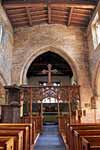 14th century chancel arch, double chamfered and rebated, with moulded octagonal imposts. The arch contains a five-bay timber screen installed in 1906. Perpendicular style, with decorative cross added in 1916. 14th century chancel arch, double chamfered and rebated, with moulded octagonal imposts. The arch contains a five-bay timber screen installed in 1906. Perpendicular style, with decorative cross added in 1916.
Medieval Cross Slabs
 Cross slabs 1-3 Cross slabs 1-3 |
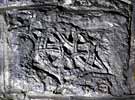 Cross slab 1 Cross slab 1 |
 Cross slab 2 Cross slab 2 |
(1) ‘The Star Stone’, a small (c 25 by 20 cm) stone built into the north face of the north wall of the nave above the western bay of the north arcade. It is rather difficult of access and was drawn from photographs; it was only discovered recently when a section of the aisle roof was removed and oblique lighting from above made it visible. A small ‘interlaced diamond’ cross within a beaded circle, somewhat damaged. This is a small-scale but quite sophisticated design which perhaps should be recorded in more detail with ladders/scaffolding; it may be of c1300, and is probably, but not definitely, part of a cross slab grave cover, one of some status.
(2) Slab now forming the internal lintel of the recess formed by the blocked north doorway. Incised straight-arm cross with simple fleur-de-lys terminals. 13th or 14th century.
(3) Slab re-used as the internal lintel of the west window of the north aisle. It has been tooled over, and the only part of the incised design that remains visible is what looks to be the tip of a sword (?) on the r. side of the slab.
Descriptions and drawings of the cross slabs courtesy of Peter Ryder.
Technical Summary
Timbers and roofs
Bellframe
Cast iron and timber, Pickford Group 8.3.C, cast iron 'A' supports with timber heads and cills, some 'X' bracing, normal height. 1894 by Mallaby of Masham, Yorkshire.
Not scheduled for preservation Grade 4.
Walls
|
NAVE |
CHANCEL |
TOWER |
| Plaster covering & date |
Open stonework |
Plastered in chancel, not aisles. |
Plastered, probably late. |
| Potential for wall paintings |
None apparent. |
Unknown, paintings possible under plaster. |
Unlikely but possible. |
Excavations and potential for survival of below-ground archaeology
No known archaeological excavations have been undertaken.
The fabric dates principally from the C13th to the late C19th with restorations in the C17th, 1882, 1894, and 1920. The tower is mainly C14th, restored following a fire in 1893. Timbers throughout have all been subject to restoration and repair but significant amounts of medieval work remain. The south porch has an intact medieval stone vaulted roof.
The churchyard is L-shaped, though perhaps originally rectangular, with the church located centrally. There are burials on all sides.
The overall potential for the survival of below-ground archaeology in the churchyard is considered to be HIGH-VERY HIGH comprising medieval construction evidence, burials, and landscaping. Below the present interior floors of the church it is considered to be HIGH-VERY HIGH comprising medieval-C20th stratigraphy with post-medieval burials. The archaeology of the upstanding fabric is largely medieval and its archaeological potential is HIGH-VERY HIGH.
Exterior: Burial numbers expected to be average.
Interior: Stratigraphy under the entire building is likely to be medieval with later layers and restoration evidence. In the body of the church the stratigraphy is likely to be punctuated by medieval and post-medieval burials.
|